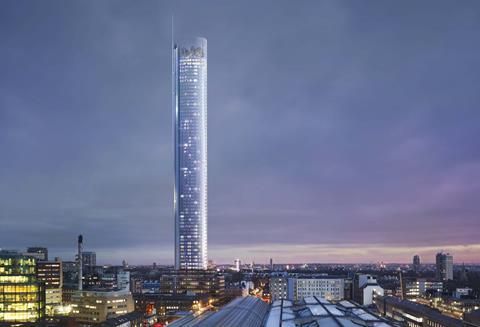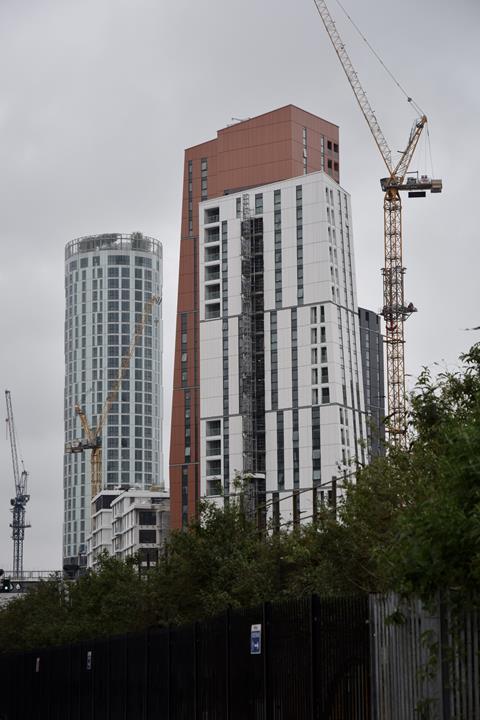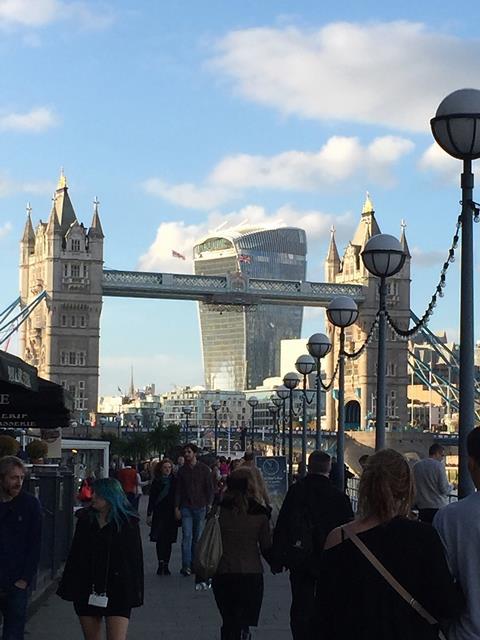Nine years on from NLA’s ‘London’s Growing Up’ exhibition, Barbara Weiss assesses the impact tall buildings have had on the capital

All too often in architectural history, it is a real challenge to define with any level of precision when a particular trend or innovation started to emerge. There can be no doubt however that the April 2014 launch of the NLA’s bombshell exhibition London’s Growing Up, marked the moment in which the lid was lifted on the Pandora’s box of tall buildings in the UK. Many evils escaped.
Not surprisingly, the high drama projection of 236 “tall buildings” (classed as those over 20 storeys), to be peppered across London’s hitherto largely pristine skyline, led instantly to an exceptionally acrimonious split in public opinion. The fierce debate it provoked was to fester for many years to come.
Season after season saw vast lecture theatres packed with outraged objectors and self-assured supporters challenging each other’s assumptions. Endless articles by heavyweight experts appeared in every manner of newspaper and magazine. A slew of TV interviews and documentaries were screened – not to mention that latest in spectator sports, the public inquiries convened to scrutinise the most controversial planning debacles.
Whatever the angle espoused – and there were so many different ones to choose from – feelings for and against tall buildings ran literally and metaphorically sky-high.
No stone was left unturned in the battle to persuade the powers that be… that the negative consequences of so many tall buildings in an historic city were a price too high to pay
As a co-founder of the Skyline Campaign, London’s most prominent group to oppose the surge of poor-quality skyscrapers across the capital, it is possible to look back today with a level of pride at what was achieved in those early years. Started specifically to curtail the worst excesses, while raising public awareness and seeking alternatives to the crude densification offered by building tall, the campaign attracted thousands of signatories from all walks of life, including many prominent supporters in the built environment and other relevant sectors.

If its greatest single victory was to have stopped in its tracks the outrageous 72-storey Paddington Pole proposal by Renzo Piano. The campaign also contributed to the preservation of several other prominent sites, either by playing a leading role or by supporting resident groups in their local fights.
In parallel, in a concerted attempt to introduce safeguards against the worst offenders, the Skyline Campaign called for the creation of a skyline commission responsible for enforcing architectural quality and for vetting locations for tall buildings; for proper consultation on a borough-wide basis; for the creation of well-considered masterplans, and for the routine use of digital modelling, a helpful new tool for assessing the impact of developments on their surroundings. Sadly, most of these suggestions were ignored or diluted beyond recognition.
It was not for lack of trying. No stone was left unturned in the battle to persuade the powers that be, and the developers involved, that the negative consequences of so many tall buildings in an historic city were a price too high to pay – one that would eventually lead London to the ultimate, irrevocable loss of its unique character and identity.
Now
Nine years on from those early days, it is devastating to observe that we, the objectors, were actually spot-on in estimating the seriousness of the risk presented to London by the brazen and unconscionable experiments conducted on its skyline.
Despite the endless debates, pro and against, if one looks around today at what London has become in 2023 it is clear that we are no longer talking about winners and losers. We are all losers.

Like a rampant disease, tall buildings of every possible shape or form have sprouted everywhere: in the most prominent parts of the city, next to our greatest historic treasures and natural assets, as well as in many of the capital’s disadvantaged residential boroughs, where they stand out as unwelcome and alien structures, blatantly highlighting the split between haves and have-nots.
It has taken less than a decade for the original dystopian CGIs first displayed at the NLA to morph into physical realities uncannily similar to their architects’ nightmarish representations. While this should not surprise (after all, CGIs are meant to be faithful representations of what is to come), it is hard to accept the sheer magnitude of the capital’s transformation, and that it happened during our generation, under our watch, and despite so many efforts to change direction.
Most of these over-sized towers are shiny, cheaply “bling” and wilfully odd-shaped. They are all-in-one monuments to developers’ greed, architects’ arrogance, a borough’s desperation and buyers’ naivety, their architectural mediocrity even more jarring after various rounds of coarse “value engineering”, or the knee-jerk addition of unwelcome extra storeys as a reaction to higher land prices.
This is not architecture, rather the worst variety of unsophisticated building.

This is not careful urban planning, or sensitive place making, rather perfunctory squeezing of inappropriate volumes onto sites for which they are too big – and paying lip-service to endless and largely meaningless bureaucratic box-ticking. It is also about reaching targets, profit levels or job creation statistics – everything other than how best to turn amazing city-wide opportunities into exciting, well-designed new neighbourhoods, with the quality family homes that are so badly needed.
It is not an exaggeration to say that the London we are now living in is even more damaged than feared possible at the time of the NLA exhibition. And, if things weren’t bad enough, we are regularly reminded that there is more to come, with the tall building pipeline expanding year on year. We are now looking at over 500 tall structures to be visited upon our city.
How and why
As Professor Tony Travers from the LSE has convincingly argued in his prescient early writings about London’s skyline, the chaotic situation we find ourselves in now can be traced back to London’s long track-record of notoriously weak and fragmented political and planning systems. This, coupled with a plethora of unique historic circumstances, several ironically due to its success, has made the city particularly resistant to reform.
So while London has been and remains one of the most important world capitals, there is a general consensus among urbanists that it is also one of the worst planned, or most un-planned, mega-cities.

Against this background, it is not surprising that London should be at the receiving end of the countless and de-stabilising disagreements between the various tiers of bodies responsible for the scrutiny and approval of its tall buildings, not to mention the long-standing frictions between boroughs.
Despite the above, and given London’s unabated universal appeal and international standing as a city, it is staggering, and highly disappointing, that since 2014 there have been so few – and only half-hearted – attempts by planners, politicians and authorities to put an end to the urban disasters that are hitting so hard areas such as Nine Elms, the South Bank and the Greenwich Peninsula (to name a few) – and also to come up with a coherent, ordered and sensitive city-wide skyline vision.
Too many opportunities have been missed. The 2016 mayoral election, which ended with Sadiq Khan taking over from Boris Johnson, started with a campaign full of promises about “better growth”; to date however it has not only delivered too few real improvements for the skyline or London’s urban planning prospects; on the contrary, it is now more than dispiriting to see the large number of incongruous developments being built under the current mayoral regime.

Indeed, London’s visual chaos is only made worse by the fact that, in all too many high-profile planning applications, it is the norm for the politicians, whether the mayor or the secretary of state – and not the planning experts! – with their own unschooled and personal take on architecture and tall buildings to have the final word on dramatic planning decisions affecting both the skyline and the vast surrounding areas of London impacted by the high visibility of new towers.
The outlook
Despite the 2022 announcement of record numbers of new planning applications and planning consents granted to tall buildings, a whiff of despondency has set in over the past few years among previously bullish supporters, reflecting a slowdown in new construction starts, and a number of unforeseen new “spanners” in the works that developers are suddenly confronting.
First and foremost are of course concerns revolving around the massive increases in construction costs, affecting viability; though the greater say given to local planning authorities and residents in the choice of appropriate sites and height of buildings is also complicating matters and causing delays.
Similarly, with sustainability issues now firmly at the fore, effective responses need to be found to the recent and irrefutable environmental research confirming in tower blocks notably higher energy usage, coupled with substantially greater embodied carbon – when compared to lower buildings of similar density.

This is not to forget recent proposals to introduce additional fire safety measures, in the wake of the Grenfell disaster, that look likely to result in secondary escape staircases mandated for tall residential buildings. If confirmed, this will potentially lead to larger building footprints, reviews of core and flat arrangements – and, of course, to significant additional costs.
Over and above these recent and evolving headaches remains the still to be resolved, and never properly addressed, conundrum of the apportionment of expenses for regular tall building maintenance, particularly in the case of residential developments in multiple ownership. It is a certainty that the costs of upkeep and replacement of lifts, cladding and services will be particularly high, and difficult to claim back from hundreds of individual UK owners, unused as they are to high service charges.
To date there have been few convincing suggestions on how any of these issues will be tackled, leading to a real fear that today’s new shiny towers might well end up as the next generation of rundown, unloved “slums in the sky”, their fate maybe even to match that of 1960s and 70s council housing, eventually and spectacularly demolished in a series of controlled explosions.
Conclusions
Nine years on, even if in a visibly less exuberant fashion than previously (with the notable exception of the City and its higher-quality tall commercial buildings), tower building continues apace, particularly in outer London, where too many boroughs have been led to believe that they need vertical icons to signify their commitment to “modernity”, and to make it onto the map of the “coolest” places to live. How wrong they are, and how they will regret this move, once the buildings are there to be counted.
The horror in respect of what has already been destroyed of London’s singular identity and proud spirit is felt very deeply and personally by many Londoners
On the other side of the fence, there are a growing number of communities still fighting desperately – mostly, sadly, with little chance of winning – to stop local skyscrapers from blighting their medium to low-rise worlds. In parallel, more and more young people are growing up having been denied the right to enjoy the beauty of London’s unscathed skyline, its once well-preserved historic neighbourhoods, and the majestic River Thames, now reduced to a multi-coloured, vulgar fun-fair pond.
Somewhat divorced from what is still happening on the ground, the lengthy and passionate debate about building tall has by now more or less fizzled out. The reality is, depressingly, that it really feels as if there is not much more to be said.
The damage has been done. The horse has bolted. The evidence is there for everyone to see.
The horror in respect of what has already been destroyed of London’s singular identity and proud spirit is felt very deeply and personally by many Londoners, akin to the sense of loss we collectively feel for the daily erosion of animal and plant species, the disappearance of natural habitats and landscapes, or of once-rich languages and traditions. These losses are forever.
However difficult, we need however to wake up to the fact that it could be much worse still – and will become so if we cannot stop the rot and make the best of what is left. While it is unacceptable that we should have been such poor stewards of the city that was left to us to cherish and protect, what now remains to be done is to pick up the pieces, as much as possible, and to continue to fight our corner. The debate must continue.
Also read >> London’s skyline is a mess. Should architects feel ashamed?
Postscript
Barbara Weiss is director of Barbara Weiss Architects
















10 Readers' comments